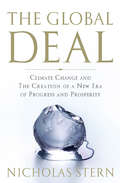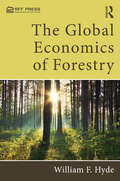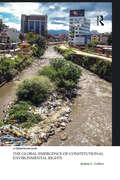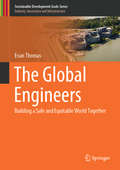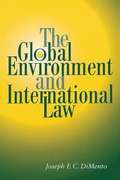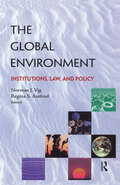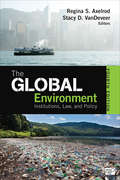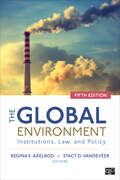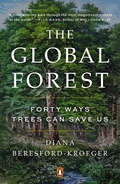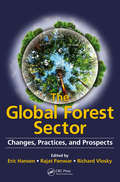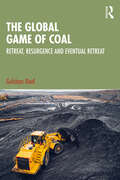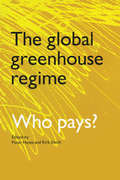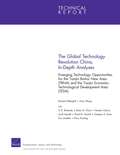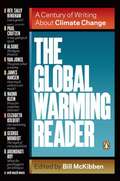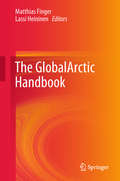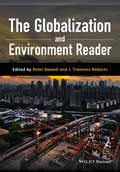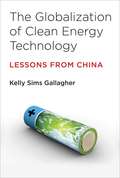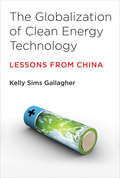- Table View
- List View
The Global Deal: Climate Change and the Creation of a New Era of Progress and Prosperity
by Nicholas SternIn October 2006, Nicholas Stern, one of the greatest economists and public intellectuals of our day, made headlines around the world with his report, which reviewed the costs and benefits of dealing with global warming. The world's community has learned that it must act to mitigate global climate change, but until the Stern Review, no one knew how much it would cost, and how to do it. Now, Stern has transformed his report into a powerful narrative book for general readers. The Global Deal evaluates the economic future, and the essential steps we must take to protect growth and reduce poverty while managing climate change.The future Stern outlines is optimistic and pragmatic; he believes we have the capacity and creativity to change. But we need the will to inspire our political leaders to drive a new global strategy.
The Global Economics of Forestry
by William F. HydeThis book traces the economic and biological pattern of forest development from initial settlement and harvest activity at the natural forest frontier to modern industrial forest plantations. It builds from diagrams describing three discrete stages of forest development, and then discusses the management and policy implications associated with each, supporting its observations with examples and data from six continents and from both developed and developing countries. It shows that characteristic distinctions between the three stages make forestry unusual in natural resource management and that effective policy requires different, even contrasting, decisions at each stage. William F. Hyde’s comprehensive discussion covers a wide range of issues, including the impacts of both specific forest policies and broader macroeconomic policies, the unique requirements of current issues such as global warming, biodiversity and tourism, and the complexities of the different forest products industries. Concluding chapters review the roles of the newer institutional landowners, of smaller private and farm landowners, and of public agencies. This highly-original volume reaches far beyond forest economics; it explains what forestry can do for regional development and environmental conservation and what policies designed for other sectors and the macro-economy can do for forestry.
The Global Emergence of Constitutional Environmental Rights (Law, Justice and Ecology)
by Joshua C. GellersOver the past 40 years, countries throughout the world have similarly adopted human rights related to environmental governance and protection in national constitutions. Interestingly, these countries vary widely in terms of geography, politics, history, resources, and wealth. This raises the question: why do some countries have constitutional environmental rights while others do not? Bringing together theory from law, political science, and sociology, a global statistical analysis, and a comparative study of constitutional design in South Asia, Gellers presents a comprehensive response to this important question. Moving beyond normative debates and anecdotal developments in case law, as well as efforts to describe and categorize such rights around the world, this book provides a systematic analysis of the expansion of environmental rights using social science methods and theory. The resulting theoretical framework and empirical evidence offer new insights into how domestic and international factors interact during the constitution drafting process to produce new law that is both locally relevant and globally resonant. Scholars, practitioners, and students of law, political science, and sociology interested in understanding how institutions cope with complex problems like environmental degradation and human rights violations will find this book to be essential reading.
The Global Engineers: Building a Safe and Equitable World Together (Sustainable Development Goals Series)
by Evan ThomasThe Global Engineers: Building a Safe and Equitable World Together, is inspired by the opportunities for engineers to contribute to global prosperity. This book presents a vision for Global Engineering, and identifies that engineers should be concerned with the unequal and unjust distribution of access to basic services, such as water, sanitation, energy, food, transportation, and shelter. As engineers, we should place an emphasis on identifying the drivers, determinants, and solutions to increasing equitable access to reliable services. Global Engineering envisions a world where everyone has safe water, sanitation, energy, food, shelter, and infrastructure, and can live in health, dignity, and prosperity.This book seeks to examine the role and ultimately the impact of engineers in global development. Engineers are solutions-oriented people. We enjoy the opportunity to identify a product or need, and design appropriate technical solutions. However, the structural and historical barriers to global prosperity requires that Engineers focus more broadly on improving the tools and practice of poverty reduction and that we include health, economics, policy, and governance as relevant expertise with which we are conversant.Engineers must become activists and advocates, rejecting ahistorical technocratic approaches that suggest poverty can be solved without justice or equity. Engineers must leverage our professional skills and capacity to generate evidence and positive impact toward rectifying inequalities and improving lives.Half of this book is dedicated to profiles of engineers and other technical professionals who have dedicated their careers to searching for solutions to global development challenges. These stories introduce the reader to the diverse opportunities and challenges in Global Engineering.
The Global Environment and International Law
by Joseph F. C. DimentoInternational law has become the key arena for protecting the global environment. Since the 1970s, literally hundreds of international treaties, protocols, conventions, and rules under customary law have been enacted to deal with such problems as global warming, biodiversity loss, and toxic pollution. Proponents of the legal approach to environmental protection have already achieved significant successes in such areas as saving endangered species, reducing pollution, and cleaning up whole regions, but skeptics point to ongoing environmental degradation to argue that international law is an ineffective tool for protecting the global environment.
The Global Environment: Institutions, Law and Policy
by Regina S. Axelrod Norman J. VigAll serious environmental threats are now international in scope and more than one thousand international environmental agreements already exist. Yet the prospects for international cooperation leading to the management of impacts on the planet remain grim. The Global Environment meets the need for an authoritative assessment of the state of international environmental institutions, laws and policies at the end of the 20th century.The book examines disagreements over the meaning of sustainable development, problems inherent in implementing environmental policies and the conflict over the exclusion of developing countries from the Kyoto Protocol. It discusses the profound trade-offs that may be required, the role of international financial interests in promoting incompatible forms of development and analyses international environmental institutions, law and policy and sustainable development.
The Global Environment: Institutions, Law, and Policy
by Stacy D. Vandeveer Regina S. AxelrodThe new edition of Regina S. Axelrod and Stacy D. VanDeveer’s award-winning volume, The Global Environment: Institutions, Law, and Policy, reflects the latest events in global environmental politics and sustainable development while providing balanced coverage of the key institutions, issues, laws, and policies. The volume has been reorganized to better highlight global environmental institutions, major state and non-state actors, and includes an expanded set of cases such as climate change, biodiversity, hazardous chemicals, ozone layer depletion, nuclear energy and resource consumption. Based on reviewer feedback, the new edition broadens coverage of the growing global environmental agenda and explores the relationships between states, NGOs, and international organizations.
The Global Environment: Institutions, Law, and Policy
by Regina S. Axelrod Stacy D. VanDeveerThe new edition of Regina S. Axelrod and Stacy D. VanDeveer’s award-winning volume, The Global Environment: Institutions, Law, and Policy, reflects the latest events in global environmental politics and sustainable development while providing balanced coverage of the key institutions, issues, laws, and policies. The volume has been reorganized to better highlight global environmental institutions, major state and non-state actors, and includes an expanded set of cases such as climate change, biodiversity, hazardous chemicals, ozone layer depletion, nuclear energy and resource consumption. Based on reviewer feedback, the new edition broadens coverage of the growing global environmental agenda and explores the relationships between states, NGOs, and international organizations.
The Global Environment: Institutions, Law, and Policy
by Regina S. Axelrod Stacy D. VanDeveerThe new edition of this award-winning volume reflects the latest events in the in global environmental politics and sustainable development, while providing balanced coverage of the key institutions, environmental issues, treaties, and policies. The book highlights global environmental institutions, major state and non-state actors, and includes a wide range of cases such as climate change, biodiversity, hazardous chemicals, ozone layer depletion, nuclear energy and resource consumption.
The Global Environment: Institutions, Law, and Policy
by Regina S. Axelrod Stacy D. VanDeveerThe new edition of this award-winning volume reflects the latest events in the in global environmental politics and sustainable development, while providing balanced coverage of the key institutions, environmental issues, treaties, and policies. The book highlights global environmental institutions, major state and non-state actors, and includes a wide range of cases such as climate change, biodiversity, hazardous chemicals, ozone layer depletion, nuclear energy and resource consumption.
The Global Environmental Crisis: The Limitations of Scientific Knowledge and the Necessity of Utopian Imagination
by John LieThe Global Environmental Crisis presents a new perspective on our inattention and inaction in the face of a major crisis. We cannot proceed without scientific knowledge, but we cannot exclusively rely on it. What we need, in addition to scientific knowledge, is utopian imagination to make us understand the nature of the crisis and to suggest an alternative vision of a viable future. This book is an essential resource for students and instructors across the social sciences, especially sociology and environmental studies. It will also be a crucial and accessible text for general readers interested in climate change and how to imagine a better world for themselves and future generations.
The Global Forest
by Diana Beresford-KroegerOne of the world's experts on how trees chemically affect the environment, Canadian scientist Diana Beresford-Kroeger is on a mission to save the planet- one newly planted tree at a time. In this new book, she skillfully weaves together ecology, ethnobotany, horticulture, spirituality, science, and alternative medicine to capture the magic spell that trees cast over us, from their untapped ecological and pharmaceutical potential to the roles they have played in our cultural heritage. Trees not only breathe and communicate; they also reproduce, provide shelter, medicine, and food, and connect disparate elements of the natural world. In celebrating forests' function and beauty, Beresford- Kroeger warns what a deforested world would look like. Her revolutionary bioplan proposes how trees can be planted in urban and rural areas to promote health and counteract pollution and global warming, maintaining biodiversity in the face of climate change. Presented in short interconnected essays, The Global Forest draws from ancient storytelling traditions to present an unforgettable work of natural history. Beresford-Kroeger is an imaginative thinker who writes with the precision of a scientist and the lyricism of a poet. Her indisputable passion for her subject matter will inspire readers to look at trees with newfound awe.
The Global Forest Sector: Changes, Practices, and Prospects
by Eric Hansen Rajat Panwar Richard VloskyChanges in production, demand, supply, and trade patterns; the impact of green building and bioenergy on industry practices and policy infrastructure; and new economies with production advantages and large consumption bases all present challenges and opportunities in the forest sector. With contributions from leading experts in academia and profess
The Global Game of Coal: Retreat, Resurgence and Eventual Retreat
by Gulshan DietlCoal occupies a large share in the global energy basket. This book explores the ‘coal game’ within the context of shifting energy geopolitics, the ‘resource war’, and the debates over climate change and energy security.Politics is a prime arena for game playing. Collaboration, competition, confrontation, and their combinations are ingredients in bilateral and multilateral dealings. The book deciphers the interactions within the coal world by resorting to the time-tested term ‘global game’. Joe Manchin in the United States, Vladimir Putin in Russia, Scott Morrison in Australia, and Gautam Adani in Australia and India have been accomplished players in the game of coal. The book looks at the coal assets and policies of major oal exporters and importers like the United States, Russia, India, Australia, and China and provides insights into the fierce contestations involved both in local and global politics and commerce over coal, climate, and security. The author discusses the role coal has played in the industrialisation of nations, prescriptions to the problem of coaluse, and varied scenarios portraying its future.The third volume in a trilogy on the use of fossil fuels, this book on coal will be of great interest to students and researchers of energy studies, international relations, environment and climate change, energy and geopolitics, security, and strategic studies. It will also be useful to policymakers, legislators, and environmentalists.
The Global Governance of Climate Change: G7, G20, and UN Leadership (Global Environmental Governance)
by John J. Kirton Ella KokotsisClimate change control has risen to the top of the international agenda. Failed efforts, centred in the United Nations, to allocate responsibility have resulted in a challenge now reaching crisis stage. John J. Kirton and Ella Kokotsis analyse the generation and effectiveness of four decades of intergovernmental regimes for controlling global climate change. Informed by international relations theories and critical of the prevailing UN approach, Kirton and Kokotsis trace the global governance of climate change from its 1970s origins to the present and demonstrate the effectiveness of the plurilateral summit alternative grounded in the G7/8 and the G20. Topics covered include: - G7/8 and UN competition and convergence on governing climate change - Kyoto obligations and the post-Kyoto regime - The role of the G7/8 and G20 in generating a regime beyond Kyoto - Projections of and prescriptions for an effective global climate change control regime for the twenty-first century. This topical book synthesizes a rich array of empirical data, including new interview and documentary material about G7/8 and G20 governance of climate change, and makes a valuable contribution to understanding the dynamics of governing climate change. It will appeal to scholars, researchers, and policy makers interested in the dynamics behind governance processes within the intergovernmental realm.
The Global Greenhouse Regime: Who Pays?
by Kirk R. SmithEffective policies to prevent global warming and climatic change are urgently required by the world community. However, international negotiations on this issue repeatedly come up against the problems of allocating responsibility for the greenhouse effect, and bearing the costs of remedying the situation.;This volume offers a multidisciplinary response to the challenge. It presents the scientific, economic and political issues and goes on to describe the policy options available. The different ways of determining responsibility for greenhouse gases and calculating obligations to pay for hazards to the environment are analyzed. The contributors examine the implications for various countries, while a concluding chapter explores climatic change negotations - what is at stake, and for whom.
The Global Guide to Animal Protection
by Archbishop Desmond Tutu Andrew LinzeyRaising awareness of human indifference and cruelty toward animals, The Global Guide to Animal Protection includes more than 180 introductory articles that survey the extent of worldwide human exploitation of animals from a variety of perspectives. In addition to entries on often disturbing examples of human cruelty toward animals, the book provides inspiring accounts of attempts by courageous individuals--including Jane Goodall, Shirley McGreal, Birute Mary Galdikas, Richard D. Ryder, and Roger Fouts--to challenge and change exploitative practices. As concern for animals and their welfare grows, this volume will be an indispensable aid to general readers, activists, scholars, and students interested in developing a keener awareness of cruelty to animals and considering avenues for reform. Also included is a special foreword by Archbishop Desmond Tutu, urging readers to seek justice and protection for all creatures, humans and animals alike.
The Global Technology Revolution China, In-Depth Analyses
by Anny Wong Richard SilberglittChina's Tianjin Binhai New Area and the Tianjin Economic-Technological Development Area commissioned a technology-foresight study to help them plan for economic growth. The authors recommend seven emerging technology applications (TAs)--solar energy, mobile communications, rapid bioassays, new water-purification systems, molecular-scale drugs, electric and hybrid vehicles, and green manufacturing--and describe drivers, barriers, and plans for each.
The Global Warming Reader: A Century of Writing About Climate Change
by Bill MckibbenOur most widely respected environmental writer brings together the essential voices on global warming, from its 19th-century discovery to the present. With the rise of extreme weather events worldwide--witness the devastation wrought by Hurricanes Sandy, Irene, and Katrina, and the sustained drought across the American West--global warming has become increasingly difficult to deny. What is happening to our planet? And what can we do about it? The Global Warming Reader provides more than thirty-five answers to these burning questions, from more than one hundred years of engagement with the topic. Here is Elizabeth Kolbert's groundbreaking essay "The Darkening Sea," Michael Crichton's skeptical view of climate change, George Monbiot's biting indictment of those who are really using up the planet's resources, NASA scientist James Hansen's testimony before the U. S. Congress, and clarion calls for action by Al Gore, Arundhati Roy, Naomi Klein, and many others. The Global Warming Reader is a comprehensive resource, expertly edited by someone who lives and breathes this defining issue of our time.
The GlobalArctic Handbook
by Matthias Finger Lassi HeininenThis book offers a systematic and comprehensive introduction to the Arctic in the era of globalization, or as it is referred to here, the ‘GlobalArctic’. It provides an overview of the current status of the Arctic as a result of global change, while also considering the changes in the Arctic that have a global effect. It positions the Arctic within a broad international context, it addresses four main themes are discussed: economics and resources; environment and earth system dynamics; peoples and cultures; and geopolitics and governance. Gathering together expert authors and building on long-term research activities, it serves as a valuable reference for future research endeavors.
The Globalization and Environment Reader
by Peter Newell J. Timmons RobertsThe Globalization and Environment Reader features a collection of classic and cutting-edge readings that explore whether and how globalization can be made compatible with sustainable development. Offers a comprehensive collection of nearly 30 classic and cutting-edge readings spanning a broad range of perspectives within this increasingly important field Addresses the question of whether economic globalization is the prime cause of the destruction of the global environment - or if some forms of globalization could help to address global environmental problems Features carefully edited extracts selected both for their importance and their accessibility Covers a variety of topics such as the 'marketization' of nature, debates about managing and governing the relationship between globalization and the environment, and discussions about whether or not globalization should be 'greened' Systematically captures the breadth and diversity of the field without assuming prior knowledge Offers a timely and necessary insight into the future of our fragile planet in the 21st century
The Globalization of Clean Energy Technology
by Kelly Sims GallagherThe development and deployment of cleaner energy technologies have become globalized phenomena. Yet despite the fact that energy-related goods account for more than ten percent of international trade, policy makers, academics, and the business community perceive barriers to the global diffusion of these emerging technologies. Experts point to problems including intellectual property concerns, trade barriers, and developing countries' limited access to technology and funding. In this book, Kelly Gallagher uses analysis and case studies from China's solar photovoltaic, gas turbine, advanced battery, and coal gasification industries to examine both barriers and incentives in clean energy technology transfer. Gallagher finds that the barriers are not as daunting as many assume; these technologies already cross borders through foreign direct investment, licensing, joint R&D, and other channels. She shows that intellectual property infringement is not as widespread as business leaders fear and can be managed, and that firms in developing countries show considerable resourcefulness in acquiring technology legally. She finds that financing does present an obstacle, especially when new cleaner technologies compete with entrenched, polluting, and often government-subsidized traditional technologies. But the biggest single barrier, she finds, is the failure of government to provide sensible policy incentives. The case studies show how government, through market-formation policy, can unleash global market forces. Gallagher's findings have theoretical significance as well; she proposes a new model of global technology diffusion that casts doubt on aspects of technology transfer theory.
The Globalization of Clean Energy Technology: Lessons from China (Urban and Industrial Environments)
by Kelly Sims GallagherAn examination of barriers that impede and incentives that motivate the global development and deployment of cleaner energy technologies, with case studies from China. The development and deployment of cleaner energy technologies have become globalized phenomena. Yet despite the fact that energy-related goods account for more than ten percent of international trade, policy makers, academics, and the business community perceive barriers to the global diffusion of these emerging technologies. Experts point to problems including intellectual property concerns, trade barriers, and developing countries' limited access to technology and funding. In this book, Kelly Gallagher uses analysis and case studies from China's solar photovoltaic, gas turbine, advanced battery, and coal gasification industries to examine both barriers and incentives in clean energy technology transfer.Gallagher finds that the barriers are not as daunting as many assume; these technologies already cross borders through foreign direct investment, licensing, joint R&D, and other channels. She shows that intellectual property infringement is not as widespread as business leaders fear and can be managed, and that firms in developing countries show considerable resourcefulness in acquiring technology legally. She finds that financing does present an obstacle, especially when new cleaner technologies compete with entrenched, polluting, and often government-subsidized traditional technologies. But the biggest single barrier, she finds, is the failure of government to provide sensible policy incentives. The case studies show how government, through market-formation policy, can unleash global market forces. Gallagher's findings have theoretical significance as well; she proposes a new model of global technology diffusion that casts doubt on aspects of technology transfer theory.
The Glory Boys: a dramatic tale of naval warfare and derring-do from Douglas Reeman, the all-time bestselling master of storyteller of the sea
by Douglas ReemanAs we've come to expect from multi-million copy bestselling author Douglas Reeman, The Glory Boys expertly weaves close and detailed knowledge of the actual events of WWII into a simply brilliant and stirring action adventure, guaranteed to have you hooked from page one. Readers of Clive Cussler, Bernard Cornwell and Wilbur Smith will not be disappointed!'One of our foremost writers of naval fiction' -- Sunday Times'Mr Reeman writes with great knowledge about the sea and those who sail on it' --The Times'A real adventure' -- ***** Reader review'Great storyline - really grips you to the end' -- ***** Reader review'Typically superbly written' -- ***** Reader review'This author never lets you down' -- ***** Reader review'Great reading -- edge of your seat stuff' -- ***** Reader review********************************************************************************They're called The Glory Boys, by those who regard their exploits with envy or contempt.January 1943: Glory Boy Bob Kearton - already a veteran and survivor of the close action in the English Channel and North Sea - is ordered to the Mediterranean and beleaguered Malta, a mere sixty miles from occupied Sicily.Unexpectedly promoted to lieutenant-commander, he is given charge of a newly formed and, as yet, incomplete flotilla of motor torpedo boats.Although the tide of defeat is thought to be turning, with the enemy no longer advancing along the North African coast, Kearton's is a new war of stealth, subterfuge, and daring, in which the Glory Boys are only too expendable.
The Go-cart Team (Rigby PM Chapter Books Emerald Levels 25-26, Fountas & Pinnell Select Collections Grade 3 Level P)
by David KeystoneHow do you build a go-cart? First of all you need a design. Next you need a list of the parts, tools, and materials that are required. And then you need to put the different parts together.When the go-cart is complete, you need the right safety equipment and lots of training. Finally, you need to give the go-cart a name -- and that's the hardest job for The Go-cart Team.
